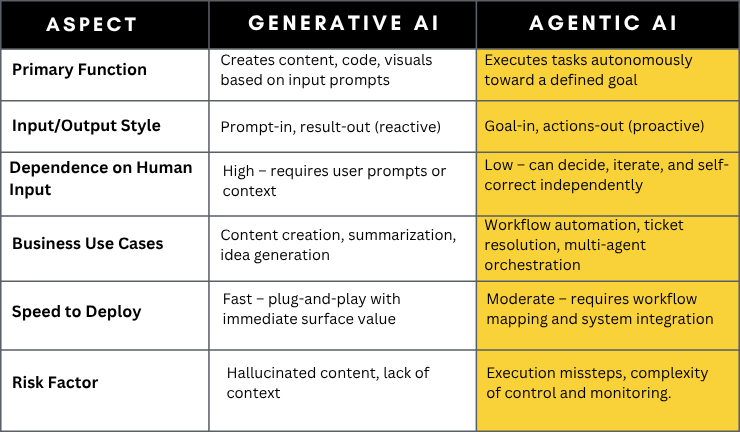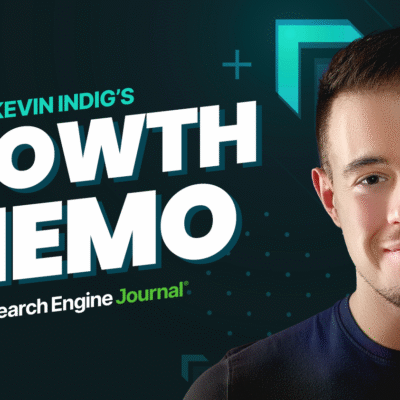Over 77% of enterprise leaders reported experimenting with generative AI tools for everything from marketing copy to code scaffolding. But less than 30% could tie those efforts to measurable ROI. Why? Because while generative AI can create, it rarely acts. (Source: McKinsey, Accenture AI Pulse)
That’s where Agentic AI enters the ring.
Imagine your business as a movie set. Generative AI is the screenwriter, it cranks out brilliant scripts and visual concepts on demand. Agentic AI? It’s the director-producer hybrid. It reads the script, casts the roles, coordinates the crew, and gets the movie made. You don’t just get ideas. You get outcomes.
As AI adoption matures, the battle lines are being drawn: Which model actually drives business value? Is it the prompt-fed powerhouse or the autonomous execution machine?
This blog breaks it all down, technology, use cases, ROI potential, and helps you decide when to deploy generative AI, when to go agentic, and when the real magic happens by combining both.
Let’s decode the hype and spotlight the AI that moves your bottom line.
What Is Generative AI vs Agentic AI?
Before we pick a winner, let’s define the contenders.
Generative AI:
Generative AI refers to models like GPT, DALL·E, and Claude that generate new content: text, images, code, and more, based on user prompts. It excels in creativity, ideation, and content generation. It’s reactive: you give it input, it gives you output.
Businesses use it for:
- Drafting marketing emails and reports
- Auto-generating code or product descriptions
- Brainstorming ideas or summarizing documents
But it stops there. Generative AI doesn’t take further action or execute.
Agentic AI:
Agentic AI goes beyond output. It acts autonomously toward a goal, continuously deciding what to do next without human input. Think of it as a self-driving AI employee that not only generates ideas but also manages tasks, coordinates across systems, and course-corrects in real time.
It uses frameworks like:
- Planning + memory + tool use (AutoGPT-style)
- Multi-agent orchestration
- Continuous learning and feedback loops
Use cases include:
- Automating multi-step workflows (e.g., onboarding, reporting)
- Handling entire support conversations or approval chains
- Triggering and executing actions based on data changes
In short: Generative AI creates. Agentic AI decides and delivers.
Generative AI vs Agentic AI: Core Difference
Both Generative and Agentic AI fall under the artificial intelligence solutions umbrella, but how they function, and the value they deliver, couldn’t be more different.
Let’s break down the core distinctions in how they operate in real-world business environments:

Why This Matters:
- Generative AI shines when you need fast content at scale.
- Agentic AI becomes invaluable when you want systems to think, decide, and act, without being micromanaged by humans.
Which AI should Business use in 2025: Agentic AI vs Generative AI
Best-Fit Scenarios for Agentic AI:
- End-to-End Workflow Automation: From triggering actions to handling exceptions, think onboarding processes, financial approvals, supply chain logistics.
- Customer Service at Scale: AI agents handling entire support cases across channels, responding, escalating, even resolving without human intervention.
- Sales Operations: AI agents qualifying leads, scheduling demos, following up, updating CRMs, automatically.
- IT & DevOps: Self-healing systems, autonomous code reviews, risk detection, and execution of remediation tasks.
Business Outcomes:
- Salesforce’s Agentforce now resolves 93% of support tickets without human input.
- Startups deploying CrewAI-like agentic stacks report 40–60% reductions in operational load.
- Internal R&D use cases show 2x faster cycle times in data collection, synthesis, and decision-making.
Best-Fit Scenarios for Generative AI:
- Marketing & Sales: Personalized email campaigns, social media posts, product descriptions, SEO-optimized blogs—generated in minutes, not weeks.
- Internal Enablement: Drafting job descriptions, training materials, performance review templates, or summarizing long docs.
- Customer Support: Auto-generating responses to FAQs, chat summaries, or escalation templates.
- Development Acceleration: Code generation, testing scenarios, or documentation drafts (paired with dev review).
Real-World Impact:
- 90% time savings on first-draft marketing content at scale (HubSpot).
- 4x productivity gains in creative agencies leveraging generative design tools.
- Enterprises using tools like Jasper, Copy.ai, and ChatGPT report quicker GTM cycles and faster ABM campaign creation.
Hybrid Strategy = Power Combo
In the AI arena, it’s not about choosing sides, it’s about stacking strengths. The real winners are tech companies that know when to use generative AI to create, and when to unleash agentic AI to act.
Together, they form a flywheel of speed and autonomy.
Real-World Example: Financial Services
- Generative AI drafts personalized loan offers based on customer data.
- Agentic AI reviews creditworthiness, initiates approvals, sends offers, and tracks status—without manual involvement.
In Healthcare:
- Generative AI summarizes patient histories and generates clinical notes.
- Agentic AI in healthcare books follow-ups, flags anomalies for review, and routes prescriptions, all in real time.
In Enterprise Ops:
- GenAI writes quarterly reports, market analysis, or compliance drafts.
- Agentic AI manages the review process, gets approvals, and submits the final docs across systems.
Why Hybrid Works:
- GenAI unlocks creative and communicative potential
- Agentic AI turns that potential into business action
- Together, they collapse manual bottlenecks and deliver intelligent orchestration across departments
This isn’t just a tech mashup, it’s a strategic alignment. One AI fills the top of the funnel. The other powers it through to the finish line.
Implementation Checklist, Making the Right AI Move
Adopting AI isn’t just a tech decision, it’s a strategic transformation. Whether you’re leaning into generative or agentic AI, successful deployment hinges on five foundational moves. Here’s your enterprise-ready checklist:
1. Assess Data Readiness and Integration Capabilities
AI thrives on quality data. Before diving in, companies must ensure their data is clean, structured, and centralized across departments. For agentic AI especially, integration is non-negotiable, your CRM, ERP, HRIS, and other systems must communicate seamlessly through APIs or middleware. Without this foundational setup, your AI initiatives will stall or generate inaccurate outputs. Conducting a lightweight data audit to evaluate accessibility, freshness, and governance is a smart way to uncover any gaps early.
2. Pilot in Controlled, High-Impact Workflows
AI adoption works best when you start small and smart. Pilots should target workflows that are high-impact but low-risk. For instance, recruitment outreach can benefit from generative AI drafting personalized messages, followed by agentic AI handling follow-ups and scheduling. Customer onboarding is another ideal candidate, where AI can generate documentation while coordinating task completion across teams. Even IT ticket triage becomes more efficient with GenAI summarizing issues and agentic AI triggering resolution steps. These are workflows where measurable results matter, and failure is survivable.
3. Define the Right Success Metrics Early
Without clear metrics, it’s impossible to gauge AI’s true value. Go beyond surface-level data like prompt count or usage frequency. Instead, define metrics that reflect operational and strategic impact. How much faster are processes post-implementation? What tangible cost savings have been realized due to reduced manual hours? How many human handoffs were eliminated from a previously fragmented workflow? Establishing these KPIs early ensures that internal stakeholders see the value and gives your teams a performance baseline to improve upon.
4. Build Governance and Escalation Paths
AI is powerful, but it needs guardrails. Especially for agentic systems that act autonomously, it’s essential to set clear boundaries and escalation paths. Determine when the AI should pause for human review, whether that’s due to a threshold being crossed, a compliance flag being raised, or a decision that exceeds its scope. Limit what data it can access and outline how ethical, privacy, and regulatory concerns will be addressed. Implementing an internal AI governance board or responsible AI framework ensures you stay on the right side of risk while scaling responsibly.
5. Scale Gradually with Success Stories
AI adoption should grow organically, fueled by wins, not mandates. Once a pilot delivers results, package the outcome into an internal success story. Share what worked, what didn’t, and how it’s already creating business value. This builds momentum, inspires experimentation, and turns skeptics into supporters. You can accelerate this further by forming an internal group of “AI Champions”, a cross-functional agile team that shares learnings, drives training, and encourages use-case exploration across the organization. With this approach, AI adoption becomes not just scalable, but sustainable.
Business Takeaways
The real battle isn’t between generative and agentic AI, it’s between short-term novelty and long-term business value. Generative AI delivers speed and scale, while agentic AI brings autonomy and orchestration. But the true competitive edge comes from knowing when to use each and how to integrate them into your core operations. That’s where ISHIR steps in. Through our Data & AI Accelerators, we help forward-thinking organizations architect intelligent, hybrid solutions that turn AI from a tool into a strategic engine. Whether you’re looking to streamline workflows, unlock new insights, or orchestrate decisions at scale, our future-ready team can help you build an AI foundation that drives impact today, and grows with you tomorrow
Still stuck choosing between GenAI and Agentic AI?
ISHIR helps you go beyond the buzz, designing AI strategies that deliver measurable outcomes, not just outputs.
The post Generative AI vs Agentic AI: Which One Wins the Battle for Business Value? appeared first on ISHIR | Software Development India.





